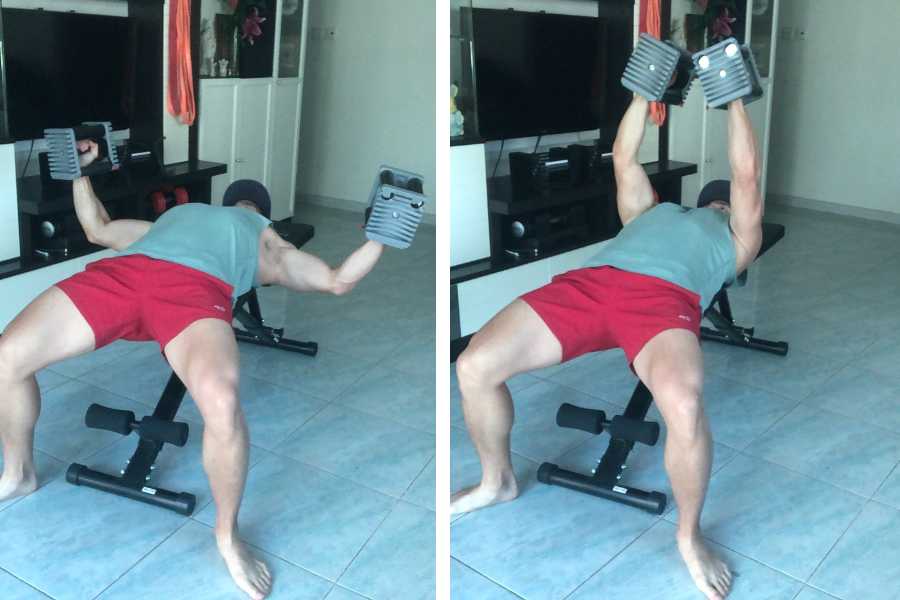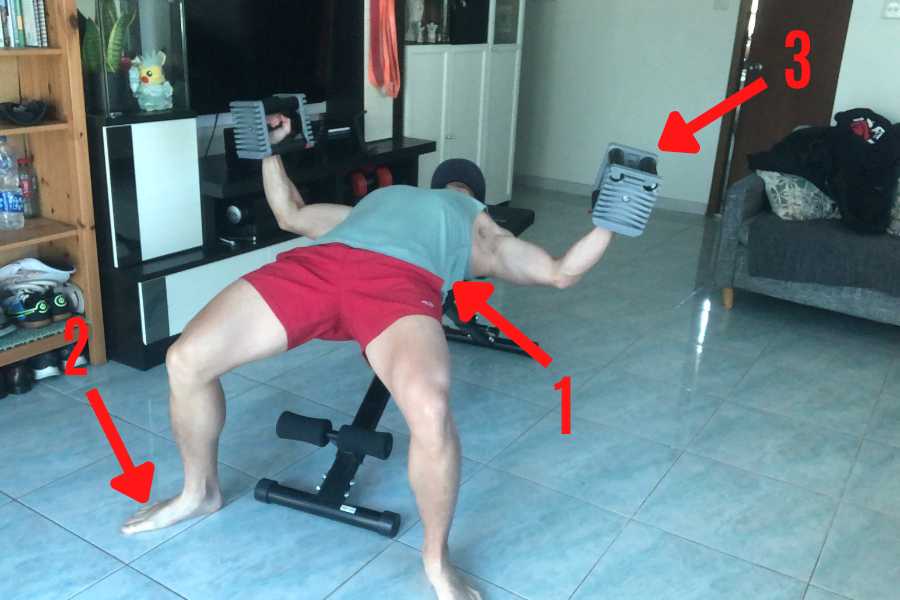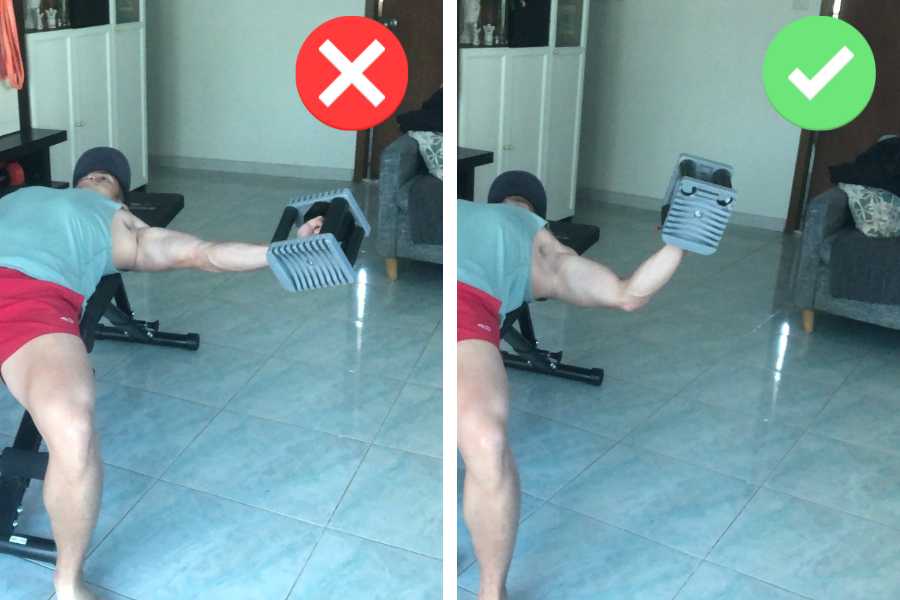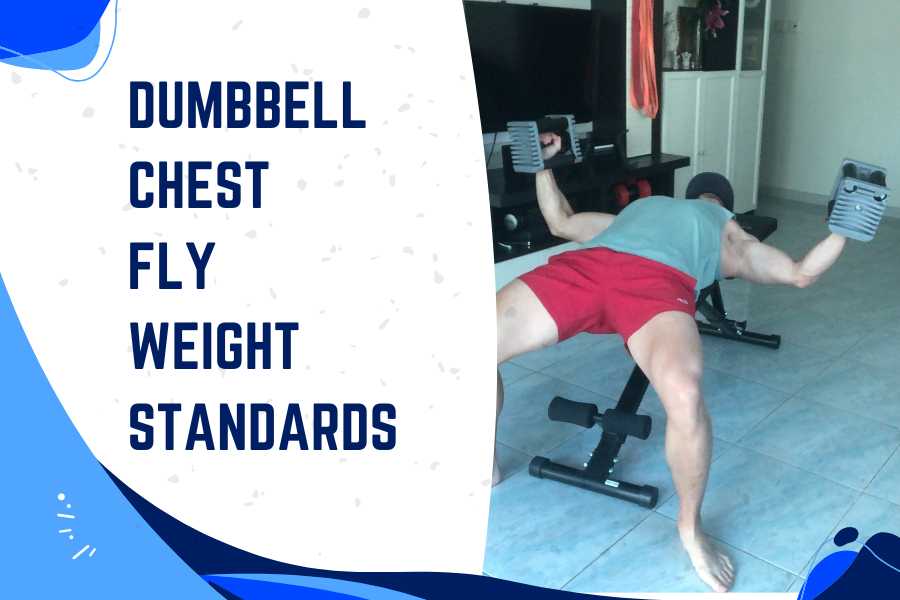Dumbbell chest flyes can be a great exercise to build bigger and more defined pecs. But it’s essential to lift the correct weight for the greatest benefits. This post reveals dumbbell chest fly weight standards for you to benchmark your own performance.
A respectable dumbbell chest fly for the average male beginner is around 15% of body weight for a single repetition (both dumbbells combined). Intermediates and advanced lifters should be able to lift around 55% and 90% (respectively) for 1 rep.
The weight standards in this post will help you determine what is a respectable weight to be lifting based on your gender, body weight, and training experience.

- How To Use These Weight Standards
- Beginner Dumbbell Chest Fly Weight Standards
- Intermediate Dumbbell Chest Fly Weight Standards
- Advanced Dumbbell Chest Fly Weight Standards
- How Good Is Your Dumbbell Chest Fly Vs Others?
- 5 Reasons Why The Dumbbell Chest Fly Is Hard
- Other Weight Standards For Dumbbell Chest Fly Muscles
- Conclusion
How To Use These Weight Standards

1) Determining your training level:
- Beginners have practiced the dumbbell chest fly for 1-12 months.
- Intermediates have practiced the dumbbell chest fly for 12-36 months.
- Advanced lifters have practiced the dumbbell chest fly for 4 years or more.
2) Choosing your rep range:
The weight standards are given for:
- 1-rep max (1RM)- this is the maximum amount of weight you can lift for a single repetition. It’s often used as a strength standard.
- 6-10 working reps- this is generally considered to be the ideal rep range for building muscle.
3) Selecting your gender and body weight:
- Average dumbbell chest fly weight standards are revealed for common body weights.
- Male standards are given.
- Females can use a 60% conversion (multiply the weight standard by 0.60).
4) Reading the charts:
- Weight standards are given as lbs on the top and kg on the bottom.
- If you’re doing the chest fly with dumbbells at or above the weight standard for your given training level, body weight, and gender, then you are lifting a respectable amount of weight.
Beginner Dumbbell Chest Fly Weight Standards
Here’s how much weight you should be lifting on the chest fly with dumbells as a beginner:
| Bodyweight | 1-rep max | 6-rep max | 7-rep max | 8-rep max | 9-rep max | 10-rep max |
|---|---|---|---|---|---|---|
| 120lb 54kg | 14lb 6kg | 12lb 5kg | 11lb 5kg | 11lb 5kg | 11lb 6kg | 10lb 5kg |
| 150lb 68kg | 22lb 10kg | 18lb 8kg | 18lb 8kg | 18lb 8kg | 17lb 8kg | 16lb 7kg |
| 200lb 91kg | 38lb 17kg | 32lb 14kg | 31b 14kg | 30lb 14kg | 30lb 13kg | 28lb 13kg |
| 250lb 113kg | 52lb 24kg | 44lb 20kg | 43lb 19kg | 42lb 19kg | 41lb 18kg | 38lb 17kg |
| 300lb 136kg | 66lb 30kg | 55lb 25kg | 54lb 25kg | 53lb 24kg | 51lb 23kg | 48lb 22kg |
Weights are for 2 dumbbells combined.
Generally speaking, beginners should be able to chest fly with dumbbells that weigh 10 to 20% of their body weight (both dumbbells combined) for a single repetition (1-rep max).
Intermediate Dumbbell Chest Fly Weight Standards
Here’s how much weight you should be lifting on the dumbbell chest fly as an intermediate:
| Bodyweight | 1-rep max | 6-rep max | 7-rep max | 8-rep max | 9-rep max | 10-rep max |
|---|---|---|---|---|---|---|
| 120lb 54kg | 72lb 33kg | 60lb 27kg | 59lb 27kg | 58lb 26kg | 56lb 25kg | 53lb 24kg |
| 150lb 68kg | 90lb 41kg | 76lb 34kg | 74lb 33kg | 72lb 33kg | 70lb 32kg | 66lb 30kg |
| 200lb 91kg | 120lb 54kg | 101lb 46kg | 98lb 45kg | 96lb 44kg | 94lb 42kg | 88lb 40kg |
| 250lb 113kg | 144lb 65kg | 121lb 55kg | 118lb 54kg | 115lb 52kg | 112lb 51kg | 105lb 48kg |
| 300lb 136kg | 166lb 75kg | 139lb 63kg | 136lb 62kg | 133lb 60kg | 129lb 59kg | 121lb 55kg |
Weights are for 2 dumbbells combined.
Generally speaking, intermediates should be able to chest fly with dumbbells that weigh 55 to 60% of their body weight (both dumbbells combined) for a single repetition.
Advanced Dumbbell Chest Fly Weight Standards
Here’s how much weight you should be lifting on the dumbbell chest fly as an advanced lifter:
| Bodyweight | 1-rep max | 6-rep max | 7-rep max | 8-rep max | 9-rep max | 10-rep max |
|---|---|---|---|---|---|---|
| 120lb 54kg | 120lb 71kg | 101lb 46kg | 98lb 45kg | 96lb 44kg | 94lb 42kg | 88lb 40kg |
| 150lb 68kg | 144lb 89kg | 121lb 55kg | 118lb 54kg | 115lb 52kg | 112lb 51kg | 105lb 48kg |
| 200lb 91kg | 180lb 113kg | 151lb 69kg | 148lb 67kg | 144lb 65kg | 140lb 64kg | 131lb 60kg |
| 250lb 113kg | 210lb 136kg | 176lb 80kg | 172lb 78kg | 168lb 76kg | 164lb 74kg | 153lb 70kg |
| 300lb 136kg | 236lb 156kg | 198lb 90kg | 194lb 88kg | 189lb 86kg | 184lb 83kg | 172lb 78kg |
Weights are for 2 dumbbells combined.
Generally speaking, advanced lifters should be able to chest fly with dumbbells that weigh 80 to 100% (both dumbbells combined) of their body weight for a single repetition.
How Good Is Your Dumbbell Chest Fly Vs Others?
Here’s the average percentage of people who can do the dumbbell chest fly at a fraction of their own body weight:
| Dumbbell Fly 1RM Weight (as a fraction of body weight) | % Of People Who Can Do It |
|---|---|
| 0.10x | 99% |
| 0.20x | 94% |
| 0.30x | 86% |
| 0.40x | 75% |
| 0.50x | 62% |
| 0.60x | 50% |
| 0.70x | 38% |
| 0.80x | 28% |
| 0.90x | 20% |
| 1.00x | 14% |
| 1.10x | 9% |
| 1.20x | 6% |
| 1.30x | 4% |
| 1.40x | 2% |
| 1.50x | 1% |
| 1.60x | 0.9% |
| 1.70x | 0.5% |
| 1.80x | 0.3% |
| 1.90x | 0.2% |
| 2.00x | 0.1% |
Weights are for 2 dumbbells combined.
This allows you to compare your standards with others and determine how respectable your strength standards are.
To calculate your chest fly as a fraction of your own body weight, simply divide the weight of your 1RM by your body weight.
For example: if you weigh 170lbs and your 1RM is 60lbs, then you’re lifting 0.35x your body weight (60lbs ÷ 170lbs).
The above chart indicates:
- 75% of people can dumbbell chest fly 0.40x their body weight for 1 rep. This represents the lower quartile of lifters and is a respectable weight for beginners to achieve.
- 50% of people can dumbbell chest fly 0.60x their body weight for 1 rep. This represents the median quartile of lifters and is a respectable weight for intermediates to achieve. It’s also a realistic target for beginners to aim towards with enough training.
- 25% of people can dumbbell chest fly 0.85x their body weight for 1 rep. This represents the upper quartile of lifters and is a respectable weight for advanced lifters. It’s also a realistic target for intermediates to aim towards with enough training.
5 Reasons Why The Dumbbell Chest Fly Is Hard
The pectorals (primary target muscles in the chest fly) can be notoriously difficult muscles to build.
Here are 5 common reasons why you may find it difficult to do the chest fly using dumbbells, and why your strength standards are below average.
I’ve also shared solutions for each problem.
These solutions can help to improve your chest fly.
1) Weak pectoral muscles

Dumbbell chest flyes are an isolation-type movement that primarily works the pectorals. Neighboring muscle groups see minimal activation, other than serving as stabilizers.
This can make the chest fly a difficult exercise because you don’t have other muscles facilitating the lift as you would in a compound exercise like the bench press.
Thus, you need a strong chest to perform well on the dumbbell fly.
Solution:
As a beginner, you need to use the correct dumbbell weight. Start with light dumbbells that you can lift with good form for your allotted reps.
Once you become comfortable lifting this weight, you can progressively overload by adding more weight to your dumbbells.
Generally speaking, you should always overload when you can. This will help you to increase your dumbbell chest fly strength to the weight standards given in this post.
2) Weak stabilizers

The dumbbell chest fly doesn’t just involve the pecs. The exercise also requires stabilization from neighboring muscles including the posterior, lateral, and anterior deltoids.
The deltoids serve to counteract the force generated from pectoral contraction and stabilize the shoulder joint as you perform the fly.
The dumbbell chest fly can therefore be difficult if you have weak shoulders or if you are recovering from a shoulder injury.
Solution:
You shouldn’t just rely on chest exercises to build pectoral size and strength.
The ideal chest-building program should also include a variety of exercises that strengthen your shoulders too.
Whilst many of the most popular dumbbell chest exercises will work the shoulders to a certain degree- and dedicated shoulder exercises are by no means essential- it’s also a good idea to include some deltoid movements that facilitate your dumbbell fly strength progression.
Examples include the shoulder press, front raise, lateral raise, and reverse fly.
3) Insufficient calorie and protein intake

Include more calorie-dense and protein-rich ingredients in your diet in conjunction with chest workouts to build bigger and stronger pecs.
Poor nutrition is one of the most common reasons why your pecs won’t grow.
A good nutrition plan requires you to eat surplus calories and protein to fuel muscle repair, recovery, and growth.
This is commonly known as “going on a bulk“.
Without sufficient calorie and protein intake, you can be following the best chest workout in the world and still be unable to gain noticeable strength and size.
Solution:
Eat 5-15% more calories than your maintenance calories. Your maintenance calories are what your body needs to sustain its current weight.
Additionally, ensure you eat at least 1g of protein per lb of body weight.
Planning is essential for a successful bulk. I recommend making a list of calorie-dense and protein-rich foods and start including more of these ingredients in your daily meals.
For a complete guide, you can go to my home bulking plan for skinny guys.
4) Poor movement balance

1) Arch your back, 2) plant your feet into the ground, and 3) ensure both arms travel at the same speed to improve chest fly balance.
Despite the dumbbell chest fly being a lay-down exercise, it still requires a tremendous amount of balance between the two sides of the chest as you bring the dumbbells up and down.
Furthermore, most people have a natural muscle imbalance. This means one side of the chest is stronger than the other (usually your dominant writing side).
These two factors combined can make the dumbbell chest fly difficult and may explain why your strength standards are below average.
Solution:
Practice your mind-muscle contractions. Do this by making a conscious effort to slow down the movement and perform the chest fly with both arms moving a the same speed.
Arching your back and planting your feet into the ground can also help with stabilizing your torso and improving balance.
It can also help to remove the bench altogether and practice the chest fly on the floor. This is particularly effective if you’re using a poor-quality weight bench with a narrow backrest.
5) Locked elbows

Unlocking your elbows can help you to lift more weight on the dumbbell chest fly.
Locking your elbows means your arm is completely straight from shoulder to wrist.
This is a common beginner-form mistake that can increase discomfort and severely limit the weight you lift in the dumbbell chest fly.
As a result of locking your elbows, the weight of the dumbbell falls onto the biceps and elbow joint instead of the shoulders and pectorals (the former is significantly weaker).
This will make the dumbbell fly much harder to perform and limit the amount of weight you can lift.
Solution:
Your arms should not be locked at 180°. It’s better to hold the arms at 160-140° instead.
In other words, introduce a slight bend at the elbows.
This simple form alteration puts your arm in a biomechanical advantage for your pecs to pull against. As a result, you should be able to lift more weight on the dumbbell chest fly.
And lifting heavy weights is the best way to improve your pectoral strength!
Other Weight Standards For Dumbbell Chest Fly Muscles
The dumbbell chest fly is an isolation-type movement that primarily works the pectorals in the chest. But the deltoids serve as stabilizers. Here are weight standards for other exercises that hit similar muscles:
- Dumbbell bench press– a compound horizontal pressing movement that works the pecs, delts, and triceps.
- Chest dip– body weight alternative to the bench press.
- Lateral raise– an isolation-type movement that works the lateral (side) delts.
- Reverse fly– an isolation-type movement that works the posterior (rear) delts.
- Shoulder press– a vertical compound pressing movement that works all of the deltoids and triceps.
You may also be interested in my other post on the heaviest bench press records.
Conclusion
These dumbbell chest fly weight standards help you to determine whether or not you are lifting a respectable amount of weight for your capabilities.
Beginners should be able to do 1 rep using around 15% of their body weight (both dumbbells combined). Intermediates should be able to lift approximately 55% of their body weight, and advanced lifters around 90%.
If you’re currently at or exceeding these strength standards, then you’re doing a good and respectable job.
I’ve also shared common problems and solutions to a chest fly strength that is below average.
You may also be interested in the downloadable Kalibre Blueprint PDF which details exactly how I gained 40lbs of lean muscle (it’s 100% free!). It details the exact exercises and nutrition (with printables) I used to go from skinny to ripped!


